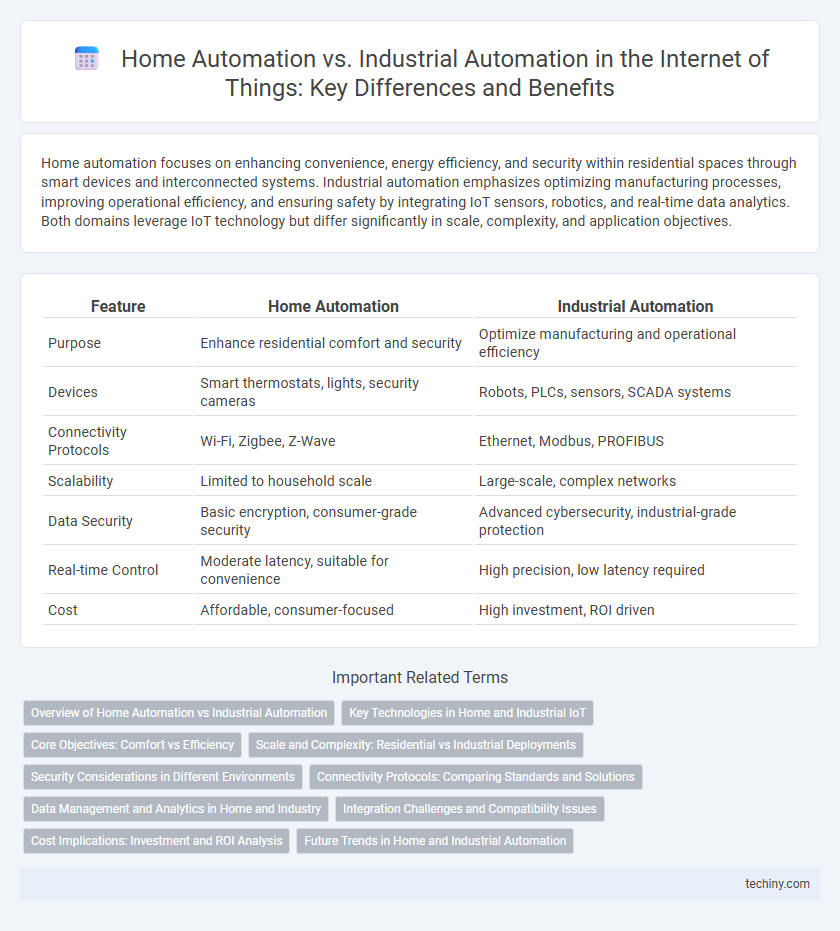Home automation focuses on enhancing convenience, energy efficiency, and security within residential spaces through smart devices and interconnected systems. Industrial automation emphasizes optimizing manufacturing processes, improving operational efficiency, and ensuring safety by integrating IoT sensors, robotics, and real-time data analytics. Both domains leverage IoT technology but differ significantly in scale, complexity, and application objectives.
Table of Comparison
| Feature | Home Automation | Industrial Automation |
|---|---|---|
| Purpose | Enhance residential comfort and security | Optimize manufacturing and operational efficiency |
| Devices | Smart thermostats, lights, security cameras | Robots, PLCs, sensors, SCADA systems |
| Connectivity Protocols | Wi-Fi, Zigbee, Z-Wave | Ethernet, Modbus, PROFIBUS |
| Scalability | Limited to household scale | Large-scale, complex networks |
| Data Security | Basic encryption, consumer-grade security | Advanced cybersecurity, industrial-grade protection |
| Real-time Control | Moderate latency, suitable for convenience | High precision, low latency required |
| Cost | Affordable, consumer-focused | High investment, ROI driven |
Overview of Home Automation vs Industrial Automation
Home automation involves the integration of IoT devices to control lighting, HVAC, security systems, and appliances, enhancing comfort and energy efficiency in residential settings. Industrial automation leverages IoT sensors, controllers, and analytics to optimize manufacturing processes, improve safety, and enable predictive maintenance in factories and large-scale facilities. Both domains utilize IoT technology but differ in scale, complexity, and application focus, with home automation prioritizing user convenience and industrial automation emphasizing operational efficiency.
Key Technologies in Home and Industrial IoT
Home Automation leverages wireless sensor networks, smart thermostats, and voice-activated assistants to enhance energy efficiency and user comfort in residential environments. Industrial Automation relies on machine-to-machine (M2M) communication, programmable logic controllers (PLCs), and edge computing to optimize manufacturing processes and ensure real-time monitoring. Both sectors utilize IoT protocols like MQTT and CoAP, but Industrial IoT emphasizes robust security measures and scalability to handle extensive device networks.
Core Objectives: Comfort vs Efficiency
Home automation prioritizes enhancing user comfort by integrating IoT devices that enable remote control of lighting, temperature, and security systems within residential environments. Industrial automation leverages IoT technologies to optimize operational efficiency, reduce downtime, and improve productivity through real-time monitoring and predictive maintenance. While home automation focuses on personalized user experience, industrial automation targets maximizing performance and cost-effectiveness in manufacturing processes.
Scale and Complexity: Residential vs Industrial Deployments
Home automation systems typically manage fewer devices within a single residence, emphasizing user-friendly interfaces and energy efficiency. Industrial automation involves large-scale deployments across multiple facilities, integrating complex systems such as SCADA and PLCs for real-time monitoring and control. The scale and complexity in industrial environments demand robust cybersecurity measures, high reliability, and scalability to support extensive sensor networks and machinery automation.
Security Considerations in Different Environments
Home automation systems prioritize user-friendly security protocols such as encrypted Wi-Fi, biometric access, and device authentication to protect personal data and prevent unauthorized access. Industrial automation requires robust cybersecurity measures including network segmentation, real-time intrusion detection, and compliance with industrial standards like IEC 62443 to safeguard critical infrastructure and operational technology from sophisticated cyber threats. Differences in environment demand tailored security frameworks that address unique vulnerabilities of residential IoT devices versus industrial control systems.
Connectivity Protocols: Comparing Standards and Solutions
Home automation predominantly utilizes connectivity protocols like Zigbee, Z-Wave, and Wi-Fi, optimized for low power, easy setup, and short-range communication within residential environments. Industrial automation relies heavily on robust, high-speed protocols such as Ethernet/IP, PROFINET, and Modbus TCP, designed for real-time data exchange, scalability, and integration across complex manufacturing systems. Comparing standards reveals that home systems prioritize user-friendly interoperability, while industrial solutions focus on reliability, security, and deterministic performance for mission-critical operations.
Data Management and Analytics in Home and Industry
Home automation systems prioritize real-time data management and user-centric analytics to optimize energy consumption, security, and convenience within residential environments. Industrial automation leverages large-scale data collection and advanced analytics, including predictive maintenance and process optimization, to enhance operational efficiency and reduce downtime in manufacturing settings. Both sectors implement IoT platforms, but industrial applications emphasize robust data integration and machine learning to handle complex, high-volume datasets for critical decision-making.
Integration Challenges and Compatibility Issues
Home automation systems often face integration challenges due to the diverse range of consumer devices and proprietary protocols, resulting in compatibility issues that hinder seamless connectivity. Industrial automation requires more robust and standardized communication protocols to manage complex machinery and critical processes, but legacy systems and varying vendor standards frequently create compatibility barriers. Addressing these integration challenges demands adopting universal standards and interoperability frameworks to ensure efficient and scalable IoT deployments in both home and industrial environments.
Cost Implications: Investment and ROI Analysis
Home automation systems typically require lower initial investments ranging from $1,000 to $10,000 depending on the scale and device complexity, offering faster return on investment through energy savings and convenience. Industrial automation demands higher capital expenditure often exceeding $100,000 due to advanced machinery and integration complexity but yields significant ROI by enhancing production efficiency, reducing labor costs, and minimizing downtime. Evaluating cost implications involves balancing upfront costs against long-term operational savings, with industrial automation favoring large-scale, high-throughput environments and home automation targeting personalized functionality and comfort.
Future Trends in Home and Industrial Automation
Future trends in home automation emphasize AI-driven smart devices, enhanced energy management systems, and seamless voice-activated controls, enabling personalized and efficient living environments. Industrial automation is rapidly advancing with the integration of IoT-enabled predictive maintenance, real-time data analytics, and collaborative robots (cobots) to improve operational efficiency and reduce downtime. Both sectors are increasingly leveraging 5G connectivity and edge computing to enable faster, more reliable communication and smarter decision-making processes.
Home Automation vs Industrial Automation Infographic

 techiny.com
techiny.com